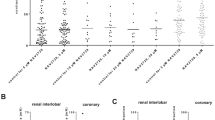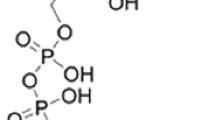Summary
We studied the effects of the l-arginine analogue NG-nitro-l-arginine (l-NNA), in comparison with its d-isomer (d-NNA), on endothelium-dependent dilations of rabbit femoral arteries (RFA) and on the release of endothelium-derived relaxant factor (EDRF) from native and cultured endothelial cells. In addition, we examined the effects of l- and d-NNA on the l-arginine- and NADPH-dependent synthesis of nitric oxide (NO) in the cytosol of porcine aortic endothelial cells. l-NNA enhanced the noradrenaline-induced contraction of endothelium-intact, but not of endothelium-denuded segments of RFA, indicating an inhibition of basal EDRF release. l-NNA also inhibited significantly the endothelium-dependent dilations to acetylcholine (ACh). Both effects of l-NNA were attenuated by l-arginine. l-NNA rapidly inhibited the release of EDRF from cultured and native endothelial cells stimulated with thimerosal or ACh. l-NNA concentration-dependently and reversibly antagonized the l-arginine- and NADPH-dependent activation of a purified soluble guanylate cyclase (GC) by cytosol from.Sreshly harvested porcine aortic endothelial cells, suggesting a direct competition between l-NNA a l-arginine at the level of endothelial NO-synthesis. d-NNA was ineffective in all instances. These results prove l-NNA to be a stereospecific inhibitor of the cytosolic NO formation from l-arginine in endothelial cells. Therefore, l-NNA will be a useful tool to elucidate the molecular mechanism of mammalian NO synthesis.
Similar content being viewed by others
References
Amber IJ, Hibbs JB, Taintor RR, Vavrin Z (1988) Cytokines induce an l-arginine-dependent effector system in nonmacrophage cells. J Leukocyte Biol 44:58–65
Bradford M (1976) A rapid and sensitive method for the quantitation of microgram quantities of protein utilizing the principle of protein-dye binding. Anal Biochem 72:248–254
Busse R, Fbrstermann U, Matsuda H, Pohl U (1984) The role of prostaglandins in the endothelium-mediated vasodilatory response to hypoxia. Pflügers Arch 401:77–83
Busse R, Pohl U, Mülsch A, Bassenge E (1989) Modulation of the vasodilator action of SIN-1 by the endothelium. J Cardiovasc Pharmacol 14, Suppl. 11: S81-S85
Furchgott RF (1988) Studies on the relaxation of rabbit aorta by sodium nitrite: the basis for the proposal that the acid-activatable inhibitory factor from bovine retractor penis is inorganic nitrite and the endothelium-derived relaxing factor is nitric oxide. In: Vanhoutte PM (ed) Vasodilatation, vol 4. Raven, New York, pp 401–414
Garthwaite J, Charles SL, Chess-Williams R (1988) Endothelium-derived relaxing factor release on activation of NMDA receptors suggests role as intercellular messenger in the brain. Nature 336:385–388
Hauschildt S, Bassenge E, Bessler WG, Busse R, Mülsch A (1989) l-Arginine-dependent nitric oxide formation and nitrite release in bone marrow-derived macrophages stimulated with bacterial lipopeptide and lipopolysaccharide. Eur J Immunol (in press)
Ignarro LJ, Buga GM, Wood KS, Byrns RE, Chaudhuri G (1987) Endothelium-derived relaxing factor produced and released from artery and vein is nitric oxide. Proc Natl Acad Sci USA 84:9265–9269
Iyengar R, Stuehr DJ, Marletta MA (1987) Macrophage synthesis of nitrite, nitrate, and n-nitrosamines: precursors and role of the respiratory burst. Proc Natl Acad Sci USA 84:6369–6373
Lückhoff A, Busse R, Winter I, Bassenge E (1987) Characterization of vascular relaxant factor released from cultured endothelial cells. Hypertension 9:295–303
Marletta MA, Yoon PS, Iyengar R, Leaf CD, Wishnok JS (1988) Macrophage oxidation of l-arginine to nitrite and nitrate: nitric oxide is an intermediate. Biochemistry 27:8706–8711
Mülsch A, Böhme E, Busse R (1987) Stimulation of soluble guanylate cyclase by endothelium-derived relaxing factor from cultured endothelial cells. Eur J Pharmacol 135:247–250
Mülsch A, Busse R, Bassenge E (1989a) Detection of nitric oxide by guanylate cyclase: comparison with the chemiluminescence method. J Vase Med Biol 1:191
Mülsch A, Hauschildt S, Bessler WG, Bassenge E, Busse R (1989b) Cytosolic nitric oxide synthesis from l-arginine by murine bone marrow macrophages and porcine aortic endothelial cells. In: Moncada S (ed) Nitric oxide from l-arginine, a bioregulatory system. Proceedings of the Royal Society Meeting, London, 1989. Elsevier, Amsterdam (in press)
Palmer RMJ, Moncada S (1988) A novel citrulline forming enzyme implicated in the formation of nitric oxide by vascular endothelial cells. Biochem Biophys Res Commun 158:348–352
Palmer RMJ, Ferrige AG, Moncada S (1987) Nitric oxide release accounts for the biological activity of endothelium-derived relaxing factor. Nature 327:524–526
Palmer RMJ, Rees DD, Ashton DS, Moncada S (1988) l-Arginine is the physiological precursor for the formation of nitric oxide in endothelium-dependent relaxation. Biochem Biophys Res Commun 153:1251–1256
Rees DD, Palmer RMJ, Hodson HF, Moncada S (1989) A specific inhibitor of nitric oxide formation l-arginine attenuates endothelium-dependent relaxation. Br J Pharmacol 96:418–424
Sakuma I, Stuehr DJ, Gross SS, Nathan C, Levi R (1988) Identification of arginine as a precursor of endothelium-derived relaxing factor. Proc Natl Acad Sci USA 85:8664–8667
Schmidt HHHW, Klein MM, Niroomand F, Böhme E (1988a) Is arginine a physiological precursor of endothelium-derived nitric oxide? Eur J Pharmacol 148:293–295
Schmidt HHHW, Nan H, Wittfoht W, Gerlach J, Prescher KE, Klein MM, Niroomand F, Böhme E (1988b) Arginine is a physiological precursor of endothelium-derived nitric oxide. Eur J Pharmacol 154:213–216
Schultz G, Böhme E (1984) Guanylate-cyclase. In: Bergmeyer HU (ed) Methods of enzymatic analysis, vol 3. Verlag Chemie, Weinheim, pp 379–389
Wallenstein S, Zucker CL, Fleiss JL (1980) Some statistical methods useful in circulation research. Circ Res 47:1–9
Wright CD, Mülsch A, Busse R, Oβwald H (1989) Generation of nitric oxide by human neutrophils. Biochem Biophys Res Commun 160:183–819
Author information
Authors and Affiliations
Additional information
Send offprint requests to A. Mdlsch at the above address
Rights and permissions
About this article
Cite this article
Miilsch, A., Busse, R. NG-nitro-L-arginine (N5-[imino(nitroamino)methyl]-L-ornithine) impairs endothelium-dependent dilations by inhibiting cytosolic nitric oxide synthesis from l-arginine. Naunyn-Schmiedeberg's Arch Pharmacol 341, 143–147 (1990). https://doi.org/10.1007/BF00195071
Received:
Accepted:
Issue Date:
DOI: https://doi.org/10.1007/BF00195071




